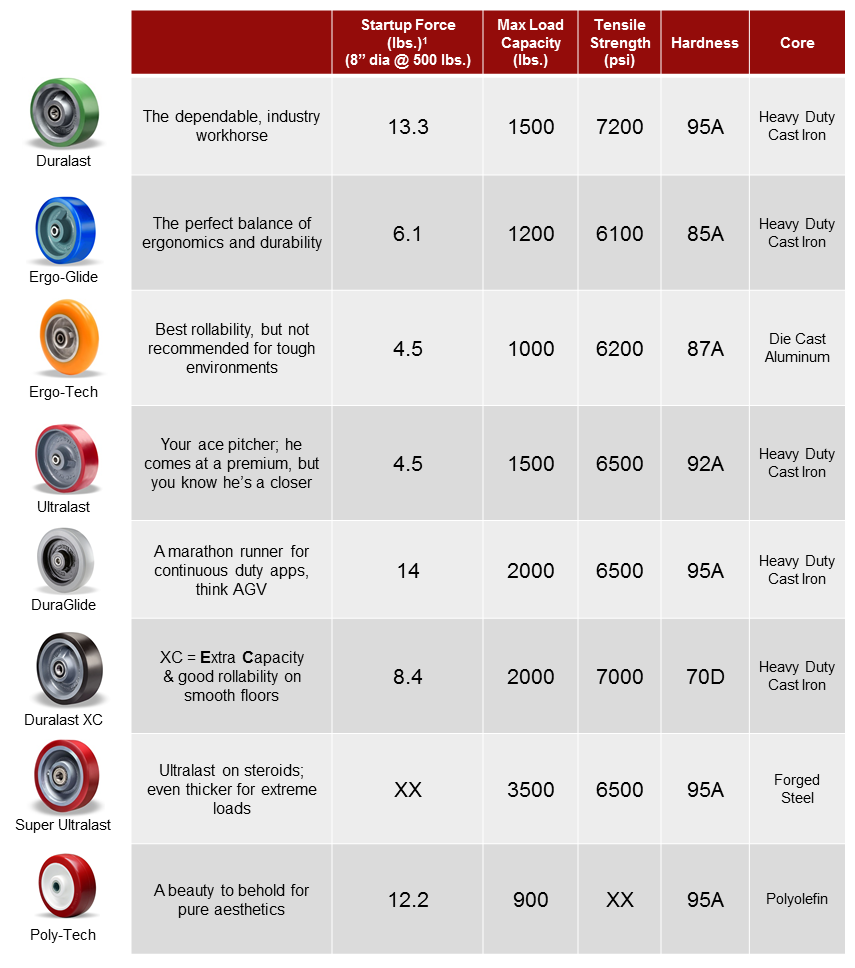If polyurethane wheels had their own playlist, “Start Me Up” by the Rolling Stones would definitely top the list. Why? Because a wheel’s startup force—or rollability—can vary significantly based on the type of poly tread used.
In fact, there are actually thousands of ways you can manipulate and cure a given urethane through creative chemistry to enhance or diminish its properties. That’s why you should never judge the quality or performance of a poly based on its color or hardness.
So which poly should you pick? That depends on your application. Today we’ll focus on three performance factors that are always top of mind: rollability, load capacity and durability.
Rollability
Say you want to order pushcarts for manual operations in your workplace. You need to choose wheels that work best for your environment, load performance and worker safety. By selecting a wheel with high rollability, you’ll make your material handlers’ job easier and safer while helping to reduce workman’s comp claims.
First, pick the largest diameter wheel that’s possible and practical for your application. The larger the diameter, the easier the wheel is to push. Second, choose a poly wheel with a low startup force. Hamilton offers several polyurethanes designed specifically for strong rebound. A high-energy poly with great rebound like the Hamilton Ergo-Tech™ is an ergonomic favorite. It’s designed to minimize push/pull forces and reduce work-related injuries.
Load capacity
The heavier your load, the more both polyurethane formulation and thickness factor into effective wheel performance. Certain poly formulas are designed to carry more weight. For example, the Duralast® XC wheel carries up to 30% more capacity than our standard Duralast® and rolls easier on smooth floors. Keep in mind, however, that most loads don’t maintain an even weight across the length and width of a pushcart. An off-center load will prematurely wear the overburdened casters. Hamilton offers 3 standard polyurethane wheels specifically engineered for extreme loads.
Durability
Heat buildup is polyurethane’s number one enemy. Good thing durability is our specialty. We maintain strict specifications on our poly with respect to tensile strength, tear strength and rebound. Some polys, like our DuraGlide™, are engineered for very low thermal retention to stand up to heavy or continuous loads for longer service life. And Hamilton Super Ultralast® represent our highest performing urethane. It features the ultimate 1” extra thick Ultralast poly molded to a super heavy-duty forged steel center for off the chart performance that outlasts the competition.
You know what they say: Tough wheel. Long life. Happy budget.
Ready for a live performance?
In total, Hamilton offers 12 standard polyurethane-treaded wheels for almost any application. All the wheels provide great floor protection, quiet operations and long use with minimal wear, but to really help you choose the right revolution for your needs, use our handy cheat sheet below.
(And in case you were wondering, the poly wheel that rolls on our production floors at Hamilton is…drumroll…the Ergo-Glide™. We like it for its great ergonomics, durability and value for the money.)

These start-up forces noted above are based on the acceleration of 22 in/sec2 which is equivalent to the acceleration from zero to 2.5 mph to a normal walking pace. A slower acceleration (slow pace) will produce smaller starting forces.
Feeling overwhelmed? Hit the easy button and call one of our inside sales engineers and we’d be happy to make a recommendation.